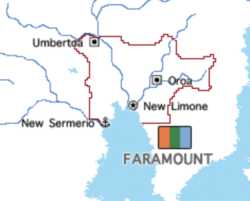New Limone
New Limone
Nuovo Limone | |
|---|---|
City | |
 | |
 | |
| Country | Faramount |
| Province | Capitol Area Region |
| Established | 1843 |
| Government | |
| • Type | Municipality |
| • Body | City Council |
| • Mayor | Sophia Terrome (National Unity Party) |
| Area | |
| • Total | 1,653 km2 (638 sq mi) |
| Population | |
| • Total | 2,483,126 |
| • Density | 1,500/km2 (3,900/sq mi) |
| Demonym | Limonese |
| Time zone | UTC-4 (Colletian River Time) |
| Postal Code | 101 |
| Area Code | 1 |
New Limone (Cristenese: Nuovo Limone) is the capital city and largest city of Faramount. The municipality contains its entire metropolitan area following several expansions of its borders during the 1990s and 2000s. New Limone has a population of 2,483,126, making it one of the largest urban areas in Alharu.
History
Humans settled the Colette River Delta tens of thousands of years ago, thriving amidst the fertile soil, plentiful wildlife, and warm climate. The Fara ethnic group came to inhabit the coastal delta including modern New Limone. During the 8th and 9th centuries, the Fara Kingdom rose to rule this area and surrounding regions, and it had a sizable capital at the location of present downtown New Limone. But following the fall of the kingdom in the tenth century, this settlement collapsed.
Derthalers settled modern New Limone in the early thirteenth century, constructing a trading outpost at the mouth of the Collette River. But the Derthalers struggled to maintain a foothold in Faramount due to the spread of disease, particularly malaria. The Derthalen settlement, Faraberg, would have a popultaion of just 35,5000 in 1450, of which only 5,000 were Derthalers. The Holy Empire lost interest in the region in the late fifteenth century, and by the mid sixteenth century, had completely withdrawn. Yet the settlement of Faraberg remained in existence, populated by local Farans.
Limonaian explorers took over control of Faraberg in the mid sixteenth century, renaming it New Limone. The Limonaians constructed a sizable trading post there, and by 1860, nearly 50,000 Limonaians resided in what is now central New Limone. Limonaia largely engaged in a system of indirect rule in Faramount, but it directly administered New Limone, and the city would become one of the most developed in the region. New Limone's population would more than triple in the 1873-1884 Faramontese gold rush. The city's economy in this period largely relied upon shipping and government.